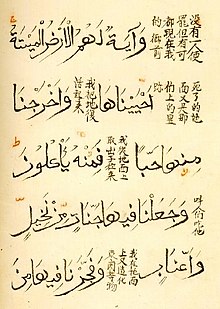
Back خط صيني عربي Arabic Sini AST সিনি লিপি Bengali/Bangla Sini (cal·ligrafia) Catalan Sini Spanish خط صینی Persian Sini (écriture) French Sini (scrittura) Italian 中国 (書体) Japanese Tulisan Sini Malay

| Part of a series on |
| Calligraphy |
|---|
 |
| Part of a series on Islam in China |
|---|
 |
|
|
Sini (from Arabic: ٱلْخَطُ ٱلصِّينِيُّ, Al-khaṭ as-ṣīnī, lit. 'The Chinese script') is a calligraphic style used in China for the Arabic script. While Sini Script can refer to any type of Arabic Calligraphy influenced by Chinese Calligraphy, it exists on a spectrum in which the amount of Chinese influence increases as it is found further East.[1][2] While Sini script resembles thuluth script, it is adapted to local styles in Chinese Mosques.[3][4] Although Sini script exists on a broad spectrum, the most well-known form of Sini script, standardized during the Ming Dynasty, is characterized by its "round, flowing" Arabic letters featuring the "tapered" style more commonly found in Chinese calligraphy.[5] It is also characterized by its thick horizontal and fine vertical strokes, a result that is due to the use of a brush rather than a qalam, which is the traditional writing pen for Islamic calligraphy.[4]
One notable Sini calligrapher is Hajji Noor Deen Mi Guangjiang (b. 1963).[6][1]
- ^ a b Stöcker-Parnian, Barbara (2013). Gharipour, Mohammad (ed.). Chapter Eight Calligraphy in Chinese Mosques: At the Intersection of Arabic and Chinese Calligraphy in "Calligraphy and Architecture in the Muslim World". Edinburgh University Press. p. 145.
- ^ Smith, G. Rex (1994). Roper, Geoffrey (ed.). "World survey of Islamic manuscripts". Journal of the Royal Asiatic Society. 6 (2): 234–235. doi:10.1017/S1356186300007264.
- ^ Armijo, Jacequeline (2008). "Islam in China". Asian Islam in the 21st Century. Oxford University Press. p. 203.
- ^ a b Ghoname, Hala (2015). Sini Calligraphy: The Preservation of Chinese Muslims' Cultural Heritage. LAP Lambert Academic Publishing. p. 31. ISBN 9783659776519.
- ^ Garnuet, Anthony (March 2006). "Islamic Calligraphy in China". China Heritage Newsletter. Retrieved April 23, 2024.
- ^ Cite error: The named reference
:6was invoked but never defined (see the help page).